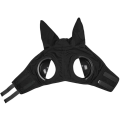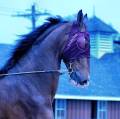Other Devices Used on Horses
© Copyright Disclaimer under section 107 of the Copyright Act 1976, allowance is made for “fair use” for purposes such as criticism, comment, news reporting, teaching, scholarship, education and research. Fair use is a use permitted by copyright statute that might otherwise be infringing.
All images used in this document fall under “fair use” as they are being used for educational purposes only. I do not profit off any of this. If you are the copyright holder and wish for me to link to your website, please contact me and I am more than happy to do so!
This paper is about various devices used on horses to force control. Please, see facts on bits, whips, and spurs to learn about those torture devices.
This list is split onto two pages to make is easier for loading.
Directory:
First Page:
Second Page:
- Bit Burrs:
- Rein Burrs:
- Overchecks:
- Headpoles (Boring Poles):
- Curb Chains:
- Tongue Ties:
- Tongue Clips (Gaits):
- Serretas de Muserola (Professoras):
- Twitch:
- Earplugs:
- Jawbreakers:
- Cruppers:
- Blind Folds:
- Martingales:
- Hobbles:
- Shackles:
- Bit Lifters:
- Cheekers:
- Tails Chains and Butt Plugs:
- Breathing Aids:
- Gum Protecto:
- Video Scope:
- Anti Bite Armor:
- Other Gear:
This is the most comprehensive list of devices used on horses to force control by implementing pain, fear, and/or sensory deprivation. This paper does not contain anything about bits, whips, or spurs. To learn more about those please see these papers:
Bits: https://thevegandragon.com/index.php/educational-journals/animals-as-entertainment/bit-encyclopedia/
Whips and spurs: https://thevegandragon.com/index.php/whips-and-spurs/
To see a list of rulebooks of where this gear is allowed, here are some OFFICIAL PDFs for different countries and industries:
Canadian Harness Racing Gear Rulebook: https://drive.google.com/file/d/1lSXnTKZgmxpR_-mZ7Id2i3fQV20blANR/view?usp=sharing
Hong Kong Jockey Club Gear Rulebook: https://drive.google.com/file/d/13qfgyFOi6qBq6CaZiuTEUib9LP4cVYEc/view?usp=sharing
French Thoroughbred Racing Gear Rulebook: https://drive.google.com/file/d/1fgPcLM3bxks4mEcQPg2WzVxOvMRlpS_z/view?usp=sharing
Italian Thoroughbred Racing Gear Rulebook: https://drive.google.com/file/d/1TQ0a2QcIakcLhVf2_GK8MufX_b0VPAAe/view?usp=sharing
Australian Thoroughbred Racing Gear Rulebook: https://drive.google.com/file/d/177FugLHvea3TPT-hBXb4JjVScfWebH7H/view?usp=sharing
Victoria, Australia Thoroughbred Racing gear Rulebook: https://drive.google.com/file/d/1maUz4bz6q2Gh2T09pOY260w6KzzM68r8/view?usp=sharing
New Zealand Thoroughbred Racing Gear Rulebook: https://drive.google.com/file/d/1CHlaw51YjC9CLvtESTgpKWFWrvy6Tiza/view?usp=sharing
Us Eventing Rulebook: https://drive.google.com/file/d/1yM_kqfZsBSXPFbnQpAeVYlk7Jh7d4zsC/view?usp=sharing
US Dressage Equipment Rulebook: https://drive.google.com/file/d/1cBTL0eeBq0TOU-c5-Y-s_-mAvh9Dz3gm/view?usp=sharing
FEI Eventing Gear Rulebook: https://drive.google.com/file/d/1jYx_AARVUo80uAGIs6Q-9MoG3L_-bCZE/view?usp=sharing
RDA Equipment Rulebook: https://drive.google.com/file/d/1ZPdK_XaQR7SHEOWnCB2NDv-QgQRIIVaZ/view?usp=sharing
And here are some catalogs so you can see all of these devices being advertised:
https://drive.google.com/file/d/1jJEGBRqAMe44l5MQLqgwP-mimSwGGBfv/view?usp=sharing
https://drive.google.com/file/d/1-IKyjvxexWkRiow15Fja0LhpthKx9Vgr/view?usp=sharing
https://drive.google.com/file/d/1gbR9bmtp_ybYDLmHj0dbM4M4bTFWIihj/view?usp=sharing
Before we begin, please familiarize yourself with the terminology of the anatomy of horses if you’re not aware. This will help you better understand what will be discussed.
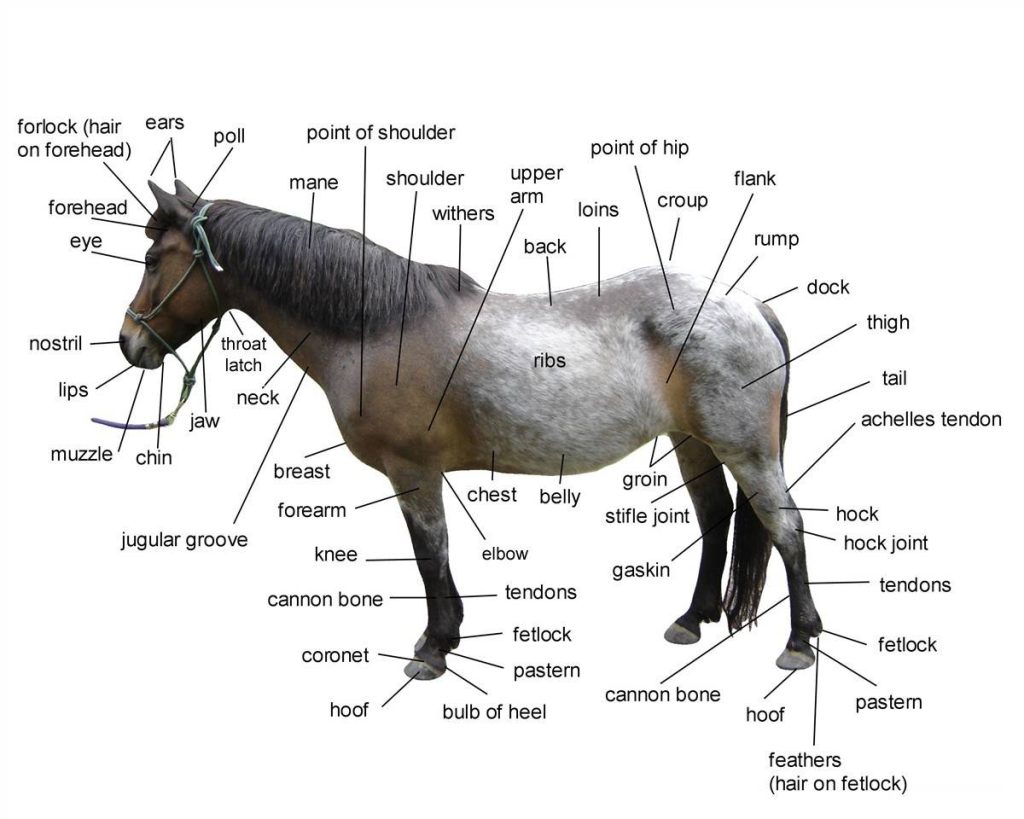
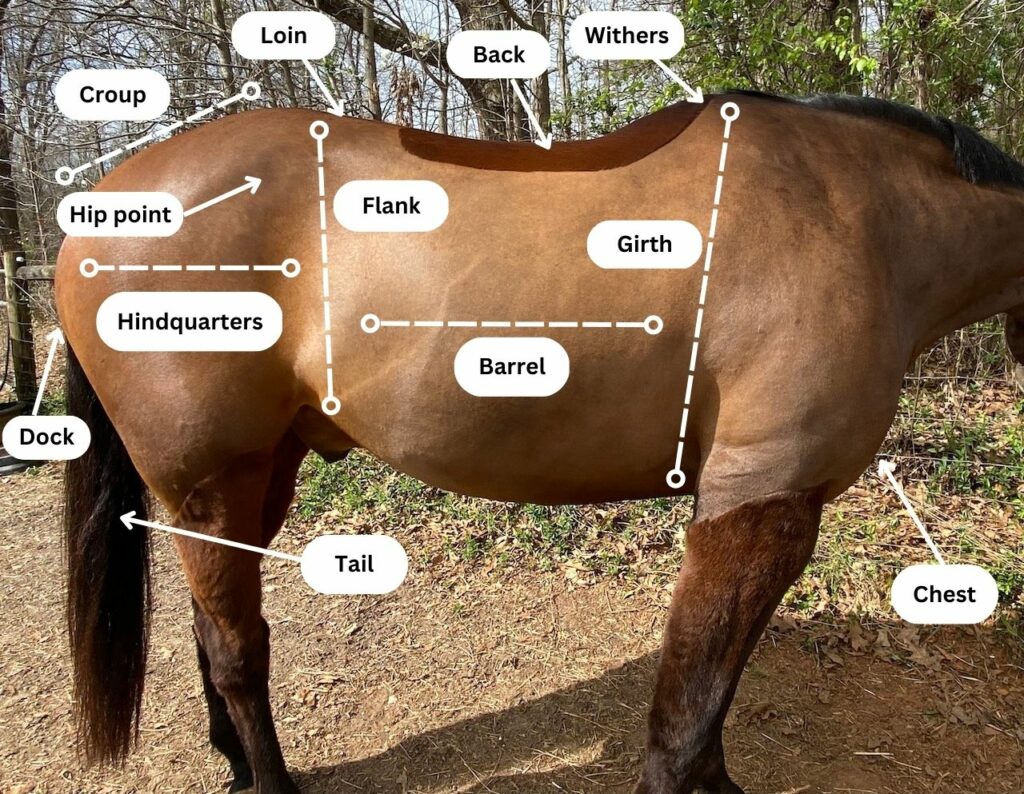
While bits, whips, and spurs are regularly used to harm horses to force them into submission, they are not the only devices used by equestrians for their sick “sports.” Here is an image of a horse with only a bridle and bit on (called an “open bridle”). This is a basic, and still painful, setup. Everything shown is added on top of this.
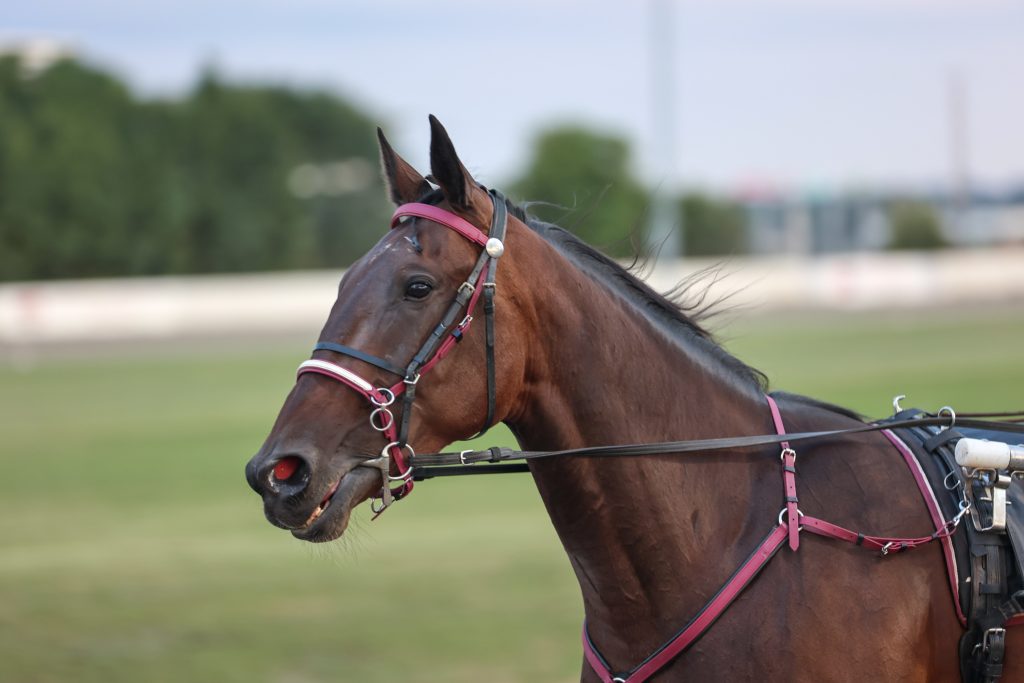
Blinders:
Blinders are perhaps as old as bits, whips, and spurs, maybe older. The purpose of a blinder is to, well, blind a horse. Horses are large prey animals, originating from Eurasia, at what is now Khazishstan. For thousands of years horses were preyed on by wolves, bears, and large cats. While many of these animals have been wiped out by humans over the centuries, the instincts of horses, even when domesticated, remain.
Horses have amazing eyesight, with their eyes located on the sides of their heads. This enables them to be able to see all around them when their heads are lowered and grazing, keeping a lookout for predators.
Should they spot anything moving suddenly, or appears to resemble a predator, horses naturally “spook,” and even run away. Even if the thing they see is harmless, such as a blanket falling off a railing, their instincts tell them it’s better to get the hell out of the area than risk a wolf pouncing out of nowhere and eating them. This survival instinct is normal for most prey animals. Even smaller predators, like cats, have it, as they, too, are at risk of being eaten by something larger.
Because of this need to flee and ask questions later, horses are easily startled and bolt at the slightest provocation. Whether that be visual or audio.
By blocking some or all of a horse’s sight it can greatly reduce their chances of being spooked and bolting. This is why horses who are used for carriages, racing, etc. always have blinders. They are forced to endure stressful, unnatural, and scary situations in crowded streets, loud racetracks, etc. and thus spook often. Horses bolting while pulling carriages is so common that in the US alone there’s about three carriage incidents every week within cities that allow carriages. In racing, bolting and panicking horses is even more common.
Using blinders can greatly reduce this, but noise and movements the horses can see, even unexpected touches, can and do cause horses to bolt in panics.
The eyesight of a horse is large, basically the only blind spots is the area behind their head, directly under them, and directly behind their rear.
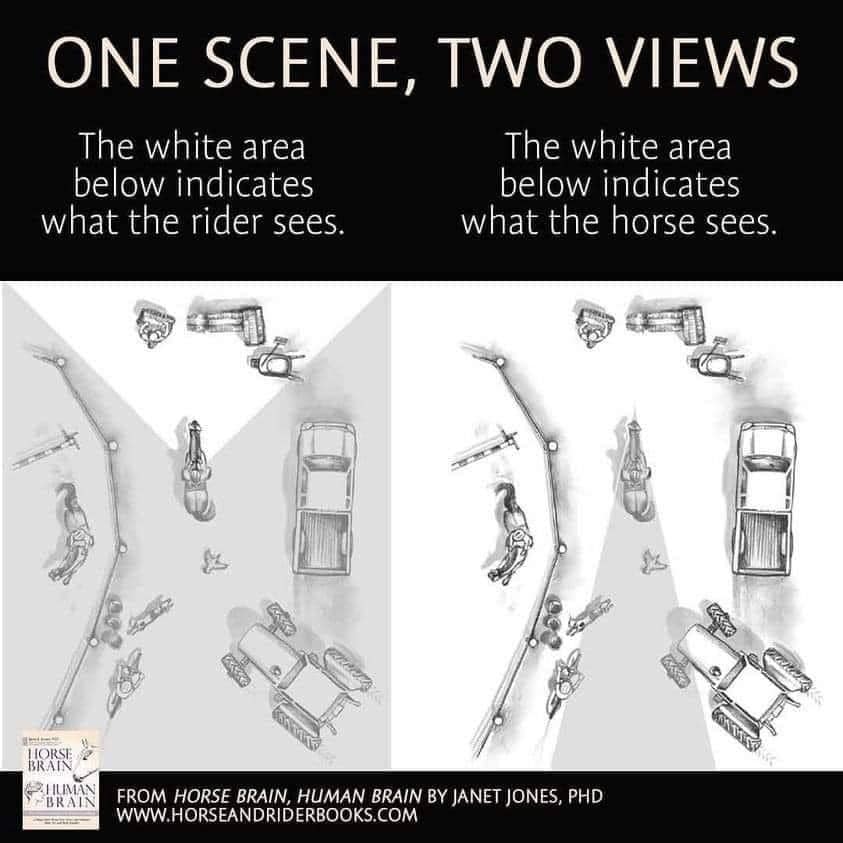
Horses have what can be described as “two types of vision.” They have “binocular vision,” which is what they see when they are directly looking at something. When you hold up a carrot and the horse fixates his eyes on that treat he is using his binocular vision. You reading this you are using your binocular vision to focus on these words.
The second vision is called “monocular vision,” which is what they see that they aren’t focused on. It’s what you see around you as you read these words. You are focused on the letters, but you also can see what’s around your phone or computer screen or paper (whatever you’re reading this on). It’s the vision that you call “saw in the corner of my eye.” You aren’t entirely focused on it, but you see it.

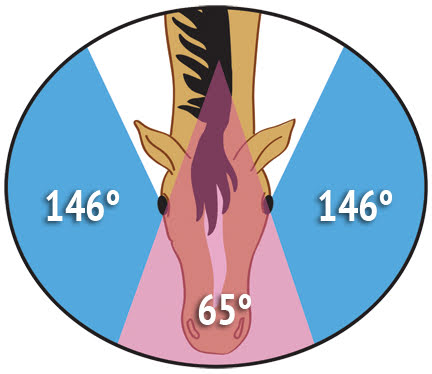
Now, humans have pretty bad eyesight compared to most animals. Eagles and hawks can see a rabbit hundreds of yards away, a crocodile has clear 180 vision, etc. And horses have amazing monocular vision. While our monocular vision is fuzzy and terrible to make out unless we actually look at the thing, horses can see VERY clearly.
That horse might not be looking directly at you, but if you’re standing on his side he can see all of your details. It might not be as clear as his binocular vision (we don’t have horse eyes so the science will probably never be solid on this), but it’s good enough he knows exactly what you’re up to.
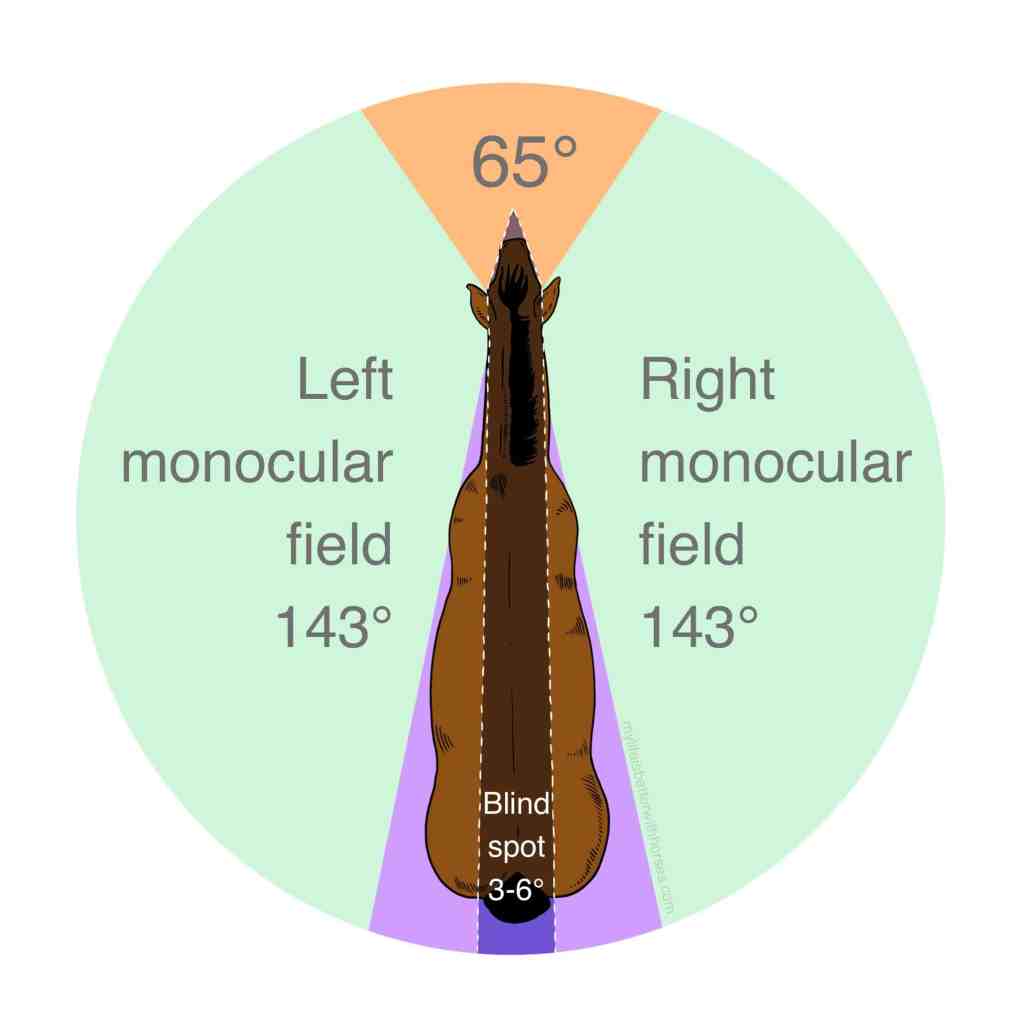
And it’s the monocular vision which is the primary target of blinders. Most blinders will be used to partially or fully block the monocular vision to prevent horses from focusing on anything behind or besides them. This is to not only help a rider or driver control them better, but also prevent spooking.
Binocular vision is also blocked or partially blocked by some types of blinders, but for most blinders they are used to block monocular vision.
Now, some equestrians, primarily the horseracing world, will lie and tell you blinders are being used to “protect” the eyes of horses from dirt and debris while they run. If this was true then all horses would be wearing clear lenses like these:
But they aren’t because the goal is NOT eye protection. The goal of blinders is to blind the horse. So, let’s go over these blinders!
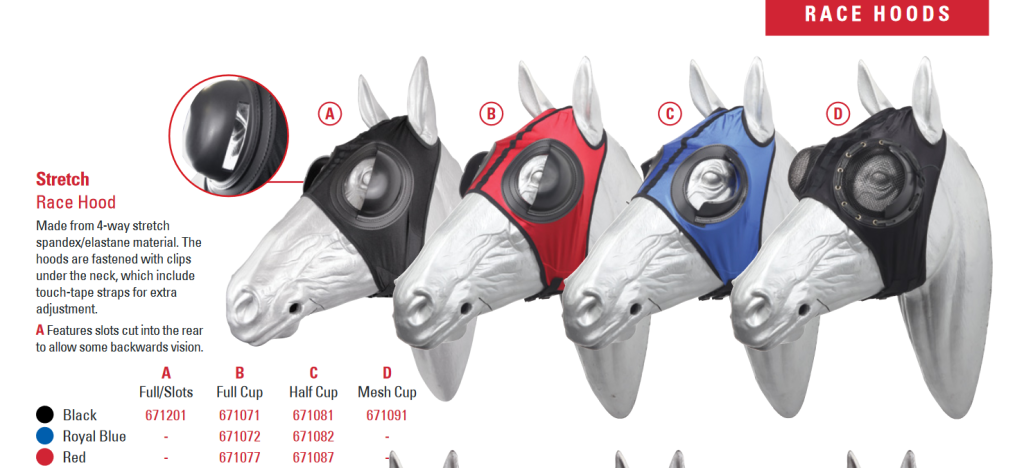
Full Cup Blinkers:
Industries used in: Thoroughbred racing, standardbred (harness) racing
Countries used in: All
Full cup blinders are perhaps the second most used blinders in horseracing. They are used in both thoroughbred and standardbred (harness) racing. A full cup blinder is usually attached to a hood, which is colorful fabric that wraps around the upper part of a horse’s head. Sometimes a hood may consist of ear muffs, which are used to deafen a horse to sound.
Full cup blinders are essentially a bowl cut in half and placed directly behind the eye. These block off ALL monocular vision, ensuring the horse can only see what’s in front of him. They are made of a hard plastic, and sometimes have parts of it drilled or cut out to give the horse a little monocular vision.
Half Cup Blinkers:
Industries used in: Thoroughbred racing, standardbred (harness) racing
Countries used in: All
Half cup blinkers are probably the most popular blinkers in the world, used on race horses for both thoroughbreds and standardbreds, and also on carriage horses. Made of a hard plastic and often attached to a fabric hood, which might also have ear muffs to deafen sound.
These blinders are designed to block all monocular vision behind a horse and most to the side. They do allow more binocular vision and a little monocular vision that a full cup blinker would normally block.
Full Cup Blinkers With Slots:
Industries used in: Thoroughbred racing, standardbred (harness) racing
Countries used in: All
Most of the time a full cup blinker is used part of it is drilled or cut into to remove parts of it. This is done to allow light to enter and help the horse with their sight adjusting, or to allow some partial monocular vision. Many times, the rider/trainer/slaver only wants to blocks the side vision of the horse and not their rear vision. Allowing the horse to see what’s in front of them and what’s behind, but not what’s to their side. This is usually done to help a horse see another horse or human approaching from behind so they don’t startle when that same being is suddenly in front of them.
Such as in racing, if a horse can see another horse approaching from behind they are less likely to spook when they suddenly see that horse in their binocular vision.
But part of their vision is still blocked preventing them from seeing everything and thus not reacting to anything on their side.
Pacifier:
Industries used in: Thoroughbred racing, standardbred (harness) racing
Countries used in: All
A pacifier is a plastic or metal mesh that is in the shape of a bowl and covers over the entire eye of a horse. It is usually on a fabric hood that may or may not have ear muffs to deafen the horse. Pacifiers are worn during races, but aren’t as common. Some pacifiers are very difficult to see through, while others are pretty thin. They also come in different colors for the mesh.
Equestrians, primarily those in horseracing, will claim these are used to “protect” the eyes from dirt, but the reality is they are used to limit the horse’s ability to see too far ahead of them. Pacifiers blur the horse’s vision, ensuring they cannot spook at objects or people in the distance, or really much around them.
Equestrians will also claim these “calm” down horses, but again, the reality is the horses’ have their eyesight restricted so much they are not calm, simply blinded to most things.
Some countries do not permit racehorses to wear these while racing, but they are allowed trackside while moving horses. Countries like Australia and Japan do allow them for during a race. America allows them on standardbreds during races, but not all states allow their use on thoroughbreds during racing.
Pacifier with Blinkers:
Industries used in: Thoroughbred racing, standardbred (harness) racing
Countries used in: All
These are simply the pacifier blinkers with an added half cup or full cup blinker added. These a little more common than the pacifier by itself because the horseracing industry loves to blind horses as much as possible to force control of them.
These are put under the same rules as the pacifiers by themselves
Leather Blinders:
Industries used in: Thoroughbred racing
Countries used in: Australia and European countries
Pretty rare blinders. These are simply a full cup, half cup, or pacifier blinder with a leather hood rather than a fabric hood. They aren’t permitted in a lot of countries, and even where they are permitted the fabric hood is still preferred. They are so rare I had difficulty finding images of them in use.
Cowls:
Industries used in: Trotting racing, standardbred (harness) racing
Countries used in: European countries, primarily France
Cowl blinders are simply a full cup blinder that’s more of a cup shape than bowl. It covers more of the horse’s eyes, blocking all monocular and some binocular vision. These are attached to a fabric hood that may or may not have ear muffs to deafen the horse.
They are not allowed in most countries, and primarily are seen in France. The ridden trotters are usually the ones wearing them, more so than the sulky pulling trotters (harness racers).
They are made of a hard plastic and do not have any holes or cuts made in them, simply blocking as much vision of the horse as possible.
Sometimes they are used on carriage horses, but often in poorer countries with no animal welfare laws. Such as India and Eastern Asian countries. Those versions are often not as well made as the ones used in the racing industry.
Telescopic (Binocular) Blinders:
Industries used in: Standardbred (harness) racing
Countries used in: All, but primarily Canada and European countries
Binocular or telescopic blinders are a very rare type of blinder. While allowed in harness racing for most countries, they only really appear in Canada, France, and a few other European countries.
These blinders are usually made of a synthetic or real leather (because who doesn’t want to abuse even MORE animals and force slaves to wear the literal skin of murder victims?) and attached directly to a bridle or by straps.
These blinders block all monocular vision, forcing the horse to only have binocular vision. But even some of the binocular vision is cut off for the bottom, front of the eye. Sometimes, they have a thin mess over them, like a pacifier, to blur their vision.
Sheepskin Cheekpieces (Winkers):
Industries used in: Thoroughbred racing, standardbred (harness) racing
Countries used in: All
Sheepskin cheekpieces, or winkers, are made of real sheep skin. Because the animal slavery industries must torture and kill as many animals as possible, so not even sheep are spared in the equestrian sports world. The racing industries require REAL sheep skin be used rather than a cruelty free synthetic one.
The winkers are used to block the monocular vision of horses, primarily for their back vision, while keeping some side vision and all frontal vision. Winkers are one of the most commonly used blinders in racing around the world, and also on many carriage horses.
Attached directly to the bridle, they may be used with a shadow roll pretty often. Sometimes inserted under or over a hood with ear muffs to deafen a horse. They may be very thick and long, thin and short, depending on how much vision the slaver/trainer/rider wishes to eradicate.
Some places may allow a synthetic fleece to be used, but it isn’t official racetracks.
Shadow Roll (Nose Roll):
Industries used in: Thoroughbred racing, standardbred (harness) racing, cross country, show jumping
Countries used in: All
Shadow rolls, often made of sheepskin (because animal slavery industries must kill and enslave as many animals as they possibly can) are placed on the noseband of a bridle, or a separate noseband is used. These are sometimes thin or very thick, depending on how much vision the slaver/rider/trainer wishes to restrict.
The shadow roll blocks a horse from seeing the ground before them. As the name suggests, it has to do with shadows. Shadows, or any movement on the ground ahead, can cause a horse to needlessly jump, believing something is there, or spook. They are primarily used in racing, but also are used on eventing horses, show jumping horses, and even carriage horses. It is immensely dangerous and foolish to use them on horses who must jump over obstacles as they block some of the steeple/jumps, but equestrians do not care for the dangers they put horses in. So, horses used for show jumping, eventing, and steeple chases still will wear them.
These are also one of the most used with other types of blinders.
Brow Roll:
Industries used in: Thoroughbred racing, standardbred (harness) racing
Countries used in: Japan
Brow rolls are used in some horseracing events, but they aren’t very common and many countries restrict them. They are made of the same fabric as shadow rolls and are placed on the brow band of a bridle, just in front of the ears.
The belief is the brow band blocks the horse from seeing above them, but horses really can’t see much of that area to begin with. They are extremely rare and the most I’ve seen them used is in Japanese thoroughbred racing.
Turnup Shadow Roll (Rollup Shadow Roll):
Industries used in: Standardbred (harness) racing
Countries used in: All
A turnup shadow roll is simply a longer version of a shadow roll that’s, well, turned up at the ends. Made out of the same material as a regular shadow roll, they are used to block shadows on the ground and the horse’s lower vision to prevent jumping or spooking at movement in front of them.
The added turn up blocks some monocular vision, and is often accompanied by some full or half cup blinkers or square blinders, effectively forcing the horse to only see directly in front of them.
They are only used in standardbred racing, and are one of the more popular gear items used.
Shady Daisy:
Industries used in: Standardbred (harness) racing
Countries used in: United States, Canada
Shady Daisy blinders are named after Shady Daisy who was the first standardbred to ever wear them. All they are is a turnup shadow row with zip ties attached. There is usually 5-10 zip ties placed along the turnup shadow roll so that the zip ties stick vertically in front of the horse’s frontal vision like a fence.
The belief is that the waving zip ties will draw the horse’s attention so they focus on them and not the track or the other surroundings.
Sometimes the zip ties are attached to a regular shadow roll, or the noseband itself. Small zip ties or really long ones may be used. Sometimes, more than 20 zip ties might be tied to the turnup shadow roll. But turnup shadow rolls are the most used with the zip ties.
While I cannot find any rules against them in other countries, they seem to only appear in the United States and sometimes Canada. They are not very common.
Leather Shadow Roll Blinder (Shadow Blind Roll):
Industries used in: Standardbred (harness) racing
Countries used in: All
The leather shadow roll is simply a shadow roll with a couple of leather pieces situated to remove even more frontal view from the horse. It acts the same as a regular shadow roll, to prevent the horses from seeing the ground so they don’t jump over shadows or startle at anything in front of them.
They are only allowed in harness racing, but are not very common.
Fan Brush Roll:
Industries used in: Standardbred (harness) racing
Countries used in: All
A fan brush roll, or “broom brush roll,” is another not very often used shadow roll. It is used in almost every country that has harness racing. Like the name suggests, it is simply a lot of plastic bristles, like what the end of a broom has, that is shaped in a half circle. This blocks the horse’s view of the ground before him so he will not jump over shadows or spook at something in front of him. It is taller than a regular shadow roll, and like a Shady Daisy, the idea is that the moving bristles will “distract” the horse’s gaze.
Those involved with horseracing will often claim they are to “protect” the eyes from flying debris, but the thickness of the brushes blocking the horse’s view easily debunks this.
Murphy Blinder:
Industries used in: Standardbred (harness) racing
Countries used in: All
Murphy blinders are one of the most commonly used blinders in the harness and trotting racing world. They are used in almost every country that has trotting races. The murphy blinder is a single plastic blinder that sometimes has a circular hole in it. There are two posable wires attached to either end of the blinder, which each possess a small, metal clamp at the end.
Only one murphy blinder is allowed on a horse at a time. They are used either alone or in addition to other types of blinders to block more monocular and side vision of a horse. The murphy blinder is attached to the bridle or to another blinder using the clamps, and can be adjusted as needed. They are a large blinder, and are often placed on horses who tend to look at or tilt more to one side or another. So placing the blinder on that side helps prevent the horse from constantly focusing on that side of them.
Full Cup (Closed Blinder):
Industries used in: Thoroughbred racing, standardbred (harness) racing
Countries used in: All
Closed cup blinders are bowl shaped blinders that entirely cover both eyes of a horse, blinding them. They are not used during races, but rather before events to transport horses or keep them still while they are tacked or even drugged. Mostly used for transporting or by vets, they are to ensure a horse stays calm during transport or a vet checkup.
One Eye Hood:
Industries used in: Thoroughbred racing, standardbred (harness) racing
Countries used in: All
One eyed hoods are fabric hoods, with or without ear muffs that deafen a horse, that have only one blinder or closed cup on an eye. These aren’t too common, but are used in racing when a horse only tends to be distracted by vision on one side of them. They are more often used for horses who injured an eye and need to keep that eye protected until recovery is complete.
The blinders are often full cup or half cup blinders, but sometimes a cowl blinder might be used. They’re more common in thoroughbred racing than standardbred.
Extended Cup Blinders:
Industries used in: Thoroughbred racing, Standardbred (harness) racing
Countries used in: All
Extended cup blinders are similar to cowls, but they cover even more of a horse’s vision. They are often only on one eye, and either are used with a half cup or full cup blinker or none at all.
Controllable Blinders (Swedish Blinders):
Industries used in: Standardbred (harness) racing
Countries used in: All
Controllable blinders are usually a square blinder or a Kant See Back blinder that is attached to long strings that the driver or rider can hold. With a pull of the string the blinders will drop down, blocking all side vision or back vision for the horse.
They are often used on horses who don’t always get distracted during a race, or tend to look around towards the end of a race (when they are being beaten more so start to panic more). When the horse starts to look around, or the driver wants them to “focus” on only what’s ahead of them, the driver or rider pulls the string, the blinds drop, and the horse’s vision is instantly blocked. The suddenly loss of vision also startles the horse which helps prompts them to run or trot faster.
Kant See Back Blinders:
Industries used in: Standardbred (harness) racing
Countries used in: All
Kant See Back blinders are one of the most commonly used in standardbred racing. They are positioned directly behind the horse’s eyes so the horse is unable to use their monocular vision to see most of what is around them, while still able to see in front and some of the side. These may be attached to the bridle or can be controlled to lift up or down by the driver.
Kant See Back blinders are plastic or leather, and are smaller than most other types of blinders. They are also used on carriage horses.
Rounded Blinders:
Industries used in: Standardbred (harness) racing, carriages
Countries used in: All
Rounded blinders are simply leather or plastic blinders positioned to the side or partly behind the horse’s eyes. They are very common for carriage horses, but sometimes are used on harness racing horses. They are rounded in shape and block out most monocular vision. They do not block frontal vision and may allow some partial side vision.
Square Blinders (Blind Blinders):
Industries used in: Standardbred (harness) racing, carriages
Countries used in: All
Square blinders are the most commonly used on horses throughout the globe for harness racing and carriages, and are one of the oldest designs. They are simply squared shaped blinders made of plastic or leather that attach to the bridle while also being propped up by hard plastic or metal wires.
They block all side and back vision, allowing the horse to only see what’s in front of him. They may be pressed up against the eyes or more open to allow more side vision.
They are often paired with other types of blinders in harness racing.
Open Eyed Square Blinders:
Industries used in: Standardbred (harness) racing
Countries used in: All
These are simply squared blinders with a circular hole in them. They allow the horse some monocular side vision, but otherwise block most side and back vision, only allowing frontal vision.
Hood Blinds (Pigeon Wing):
Industries used in: Standardbred (harness) racing, carriages
Countries used in: All
Hood or pigeon wing blinders are not very common in harness racing, but are one of the more popular blinders used on carriage horses. Mules seem to use them the most. These blinders are wing shaped, hence the name, and block all back and side vision for the animal.
Focus Blinkers (Showjumping Blinkers):
Industries used in: Show Jumping and Eventing
Countries used in: All
Focus blinders are the smallest blinders and are used on horses who do show jumps or cross country eventing. They block rear monocular vision, allowing the horse to retain most vision, but can’t see behind them.
These can be difficult to spot due to how small they are and are blended in with the bridle so to not draw attention.
Fly Masks:
Industries used in: Standardbred (harness) racing
Countries used in: All
Fly masks are used on horses to prevent flies and other bugs bothering the horses as they go about their horse lives. Often seen on horses in a field, the racing industry has implemented them as yet another device to control horses. Just like a pacifier, they blur vision so horses cannot see very well ahead of them. They are paired often with other blinders, effectively making the horses blind to everything that’s not directly in front of them.
They sometimes are also used to calm down a horse.
Mostly used in the United States, Australia, Canada, France, and other European countries.
Equivizor Racing Vizor:
Industries used in: Standardbred (harness) racing
Countries used in: All
The equivisor is a rare blinder that also protects the horse’s eyes from flying debris. It is constructed of colored and clear plastic sheets that entirely cover the horse’s eyes like goggles. Some versions may have the colored blinder part that blocks back and some side vision, while other versions are entirely clear.
It is very rare and I have only seen it used during racing in Tasmania.
Nose Flipper:
Industries used in: Standardbred (harness) racing
Countries used in: All
Nose flippers are rubber and plastic squares with cuts in them to make many thin flaps. This is places on the noseband of the bridle so that the flaps cover the nostrils of the horse. When a horse runs or trots the flaps will fly upward and dance about. The belief is the moving flaps will distract the horse, like a Shady Daisy with the zip ties, and prevent the horse from paying attention to what’s ahead of them.
Those in the racing industry claim it’s to prevent dirt from getting into the nostrils, but if that was the case it would be utterly shit at it’s job as the flaps are always well off the nostrils once the horse starts to increase their speed!
These are primarily used in European countries, but do appear in the United States, Canada, Australia, etc.
Combinations:
It is rare when a blinder is used alone, especially in horseracing. There’s many combinations of various types being used together. It is so common that finding examples of blinders being used alone was difficult to find. Shadow rolls always are with some type of square or Kant See Back blinder, or a murphy blinder is in there. But now since you know all the different types it will be easier for you to breakdown combinations like these examples.
Other Blinders:
Some blinders are hand made or custom made. There’s also a few that are so rare I haven’t found a name yet, as they are only used in one country or by a particular trainer. Here are some examples:
Nosebands:
Nosebands are leather, plastic, rubber, or fabric strips used to prevent a horse from opening their mouth. Equestrians want more control of horses, and by forcing a horse’s mouth closed it makes it difficult for a horse to get their tongue over the bit. Horses do this to lessen the pain caused by the bit crushing and pinching their tongues. Equestrians need the horse to be in excruciating pain from the bit so they can control the horse.
While tongue ties are the primary method used to hold down the tongue, some industries, like dressage, do not allow for tongue ties. So nosebands are implemented instead.
There are also some types of nosebands designed to cause a horse more pain on the nose and crushing the thin nasal bone that extends down the middle of the muzzle between the nostrils. This nasal bone is very thin and delicate, and exerting pressure on it can cause immense pain, even breaking the bone.

Tight nosebands are a common issue in equestrian sports, especially dressage, eventing, and showjumping. While nosebands are used in racing, tongue ties are also implemented so tight nosebands tend to not be as common since the tongue tie is already doing most of the work.
The racing industry also uses nosebands to ensure horses breathe only through their nostrils rather than their mouth. Tight nosebands can constrict this breathing, so horses gasping for air isn’t uncommon in other industries where tight nosebands is common.
Flash Noseband:
Flash nosebands are the most common type of nosebands, used around the world and in every equestrian sport. Even used in non sporting events, such as regular riding. The flash noseband is often fabric or leather strap that goes through a loop on the noseband of a bridle. It wraps around the mouth just in front of the bit, or where the corner of the horse’s lips would be.
This noseband is often over the nasal bone, as it is placed so low down the horse’s face with a regular bridle.
Kineton Noseband:
The kineton noseband is used in some horseracing, such as UK racing, and in eventing. This noseband doesn’t keep the mouth shut, but instead puts pressure on the nasal bone for control of the horse. When the bit in pulled, the bit will push down on the metal loops around it, and thus push down on the noseband. This creates more pain and thus forces more control over the horse.
Drop Noseband:
Drop nosebands come in a variety of types, but basically is a very low sitting noseband that sits just behind the nostrils. It is used on racehorses, show jumping horses, and eventing horses to keep the horse’s mouth closed. Should the horse try to open their mouth the top of the noseband will push down on their delicate nasal bone causing pain, forcing the horse to close their mouth again.
Figure Eight Noseband (Crossover Noseband):
Right behind the flash noseband, the crossover noseband would be the most popular. This noseband makes an X shape over the horse’s face, with the top straps connecting to the bridle or another strap that runs behind the ears. While the bottom straps wrap around the mouth. These nosebands can sit lower or higher on the horse’s face depending on the design.
They are used most often in horseracing, but eventing and show jumping also implements them.
Rubber Figure Eight Noseband (Rubber Crossover Noseband):
The rubber crossover noseband is used a lot in thoroughbred racing around the globe. Just like with the regular crossover noseband, this one makes an X shape over the horse’s face and keeps the mouth closed. It does not attach to the bridle, but rather has its own strap that wraps behind the ears.
Lever Noseband (Anti Pull Noseband):
The anti pull noseband has a few different versions, but they are all essentially a half circle metal loop that connects to the bridle at one end, has a nose strap in the middle, and a chin strap on the other end. If the horse tries to open their mouth the top nose strap will put pressure on the nasal bone, forcing the horse to close his mouth again.
It is not too common, mostly used in eventing, show jumping, and daily activity, but some countries do allow it to be used on thoroughbreds.
Paris Bridle (Double Noseband):
The double noseband, like the name implies, has a second band that sits very low on the nose, right over the nasal bone. This noseband hurts the horse whenever he opens his mouth, and often is very tight. It isn’t used much, only really appearing in eventing and showjumping.
Metal Nosebands:
Metal nosebands come in a variety of types, from chains, bike chains, to metal wires wrapped in twisted copper wire. The entire purpose of metal nosebands is to cause the horse pain when pulled on. Like a Serreta, they stab into and even cut the nose of a horse, forcing them to obey the rider’s commands. They may be directly attached to a bit, part of a hackamore, or used to keep the horse’s mouth closed.
Some are what appear to be normal, leather nosebands, but have metal spikes underneath them to hide from audiences. These can be used to stab and hurt a horse without being noticed.
Other Types of Nosebands:
There are so many types of nosebands, often simply called by the name of the bridle. They all do the same thing which is keep the horse’s mouth closed and/or cause immense pain to the nasal bone to force control of the horse. Here are some examples of lesser used nosebands.
https://www.psofsweden.com/us/category/bridles-reins/bridles/jumper-bridles?scrollY=1372.800048828125
https://www.totalhorse.co.uk/the-different-types-of-nosebands/
https://en.wikipedia.org/wiki/Noseband
https://horsesport.com/horse-news/new-study-measures-noseband-pressure/
Study on Noseband Pressure: https://horse-sport.s3.ca-central-1.amazonaws.com/wp-content/uploads/2024/06/06151105/Noseband-pressure.pdf
Stableizers and Lip Chains:
Stableizers:
Stableizers is a recent invention that is used in thoroughbred racing throughout the US and spreading to other countries. Started by the slave owner of Street Sense, the stableizer is simply a rope with a pulley system that wraps around a horse’s head, going under the upper lip and pressing against the gum. This rope against the upper gum causes pressure and pain, which causes a horse to not want to move their head much. The gums are incredibly sensitive, and equestrians have been exploiting this delicate part of the body using bits and chains for thousands of years.
Place a rope on your upper gums right where the lip attaches, then pull back on either side with your hands holding the rope behind your head. Keep the pressure tight and try moving your head around. You will quickly find it is not comfortable at all!
But equestrians spread a lie that this abuse releases endomorphins, when in reality it just hurts!
Stud Chains:
Stud chains, stallion chains, chain leads, whatever they are called, they are one of the most commonly used methods of hurting a horse for control around the globe. A horse has a halter placed on them, then the clip of the stud chain is attached to the halter on one side. The chain is then looped over the upper gums of the horse, passed through a ring of the halter on the opposite side, and the rest of the lead held by whoever is moving the horse. This way, they can yank the chain and cause serious pain to the horse’s gums!
They sometimes will wrap the chain with rubber or fabric to lessen the pain or try to hide it. Sometimes, the lead is a rope that’s being used against the horse’s gums, but chains are more common.
The reason they are called stud chains is because they were and still are regularly used to force stallions to breed with mares. They put them onto the stallion, yank his mouth around, and force him to mount and rape a tied down mare. Because of how much easier they made it to rape horses, stud chains became popular everywhere to force horses to do things they don’t want to do.
Lip Chain:
A lip chain is a mixture of the stud chain and stableizer. All it is is a length of chain with some fabric or leather strap attached to either end making a loop. This is placed under the horse’s upper lip and around the ears, keeping pressure on their gums. It is heavily used in Japanese thoroughbred racing, but can be spotted in thoroughbred racing in the US, UK, and other countries.
Lip chains may also simply be a length of rope or rubber. Some may be placed behind the bit so that when the bit is pulled it will also pull the lip chain causing pain to the upper gums and the bars.
Anti-Chokers:
In standardbred racing and with carriages, horses can lower their heads and make it more difficult for a driver to control them due to the driver being behind the horse instead of on top of them. To prevent the horses from lowering their heads overchecks are normally used. Standardbred racing also implements anti chokers, which are hard plastic, rubber, or metal items that are placed directly under a horse’s jaw, right at the neck, so that the horse cannot lower their head. Doing so will cause the jaw to press the anti choker into the horse’s jugular, causing discomfort.
They are called “anti chokers” because the belief is they also help prevent a horse from choking on their own spit by keeping the airway open. But the primary cause of breathing difficulties and choking in horses is the bit. Simply removing the bit would resolve this issue and make the anti choker and overcheck unnecessary. But equestrians need to abuse their slaves in every possible manner rather than find cruelty free alternatives or bother with training.
Despite the purpose of them replacing overchecks, many horses still wear both an anti choker and an overcheck.
Protecto Anti Choker:
The protecto anti choker is a large piece that covers much of the horse’s neck and some portion of the jaw. It is connected to the throat latch of the bridle (the piece that goes across the horse’s cheeks). This anti choker is common in the United States, Canada, European Countries, and sometimes is used in Australia.
No Choke Tube (Throat Strap):
No choke Tube straps are plastic or rubber tubes that are put over the throat latch of a horse’s bridle. They are very common in Tasmania, Australian, and New Zealand racing, but are also used in other countries such as the US. They don’t cover much of the horse’s neck, but are still efficient enough to prevent a horse from being able to lower their head.
Flasher No Choke Throat Latch (Choke Plate):
Choke Plates are the most common type of anti choker. They are a simple bent, plastic piece that attaches to the throat latch of the horse’s bridle. They can be easy to miss, especially when looking at a horse’s side. They are used throughout the world, and are very common in the United States. A simple design and not very large, they prevent a horse from lowering their head. Due to the design, the edges may also stab into the horse’s throat when the reins are pulled and a horse is forced to bend their neck, causing discomfort.
Pullrole:
A pullrole, or pipe, is another common anti choker. Sometimes they are simple plumbing piping sawed into the right size, or may be a wooden or plastic solid cylinder. They are attached to the throat latch of a horse and prevent them from being able to lower their head.
List of Devices Continues on Second Page:
https://thevegandragon.com/index.php/other-devices-used-on-horses-part-2/


























